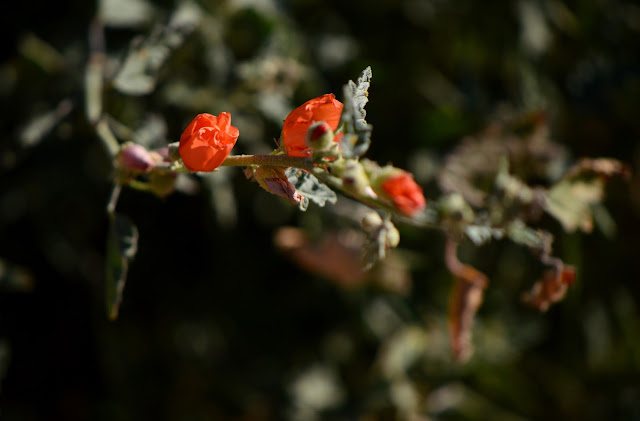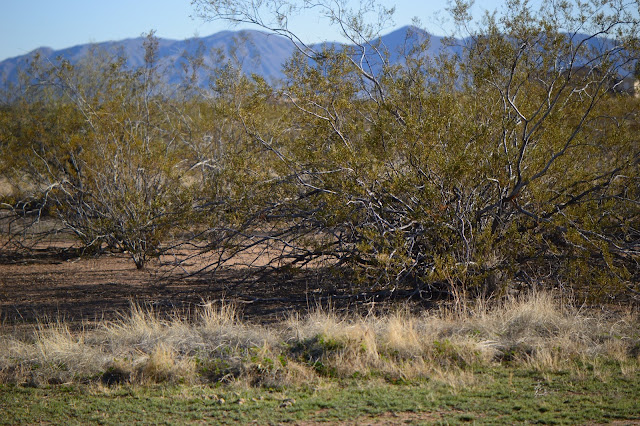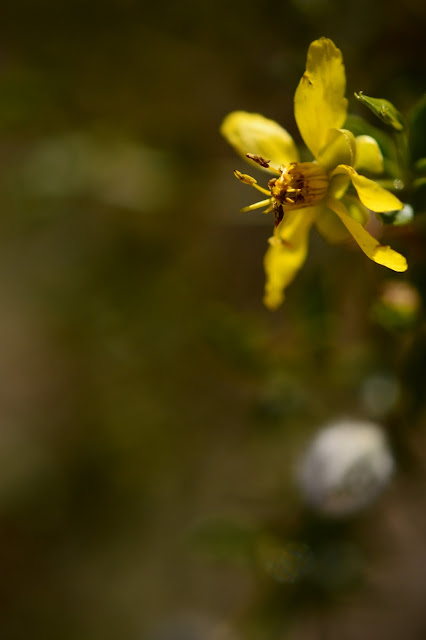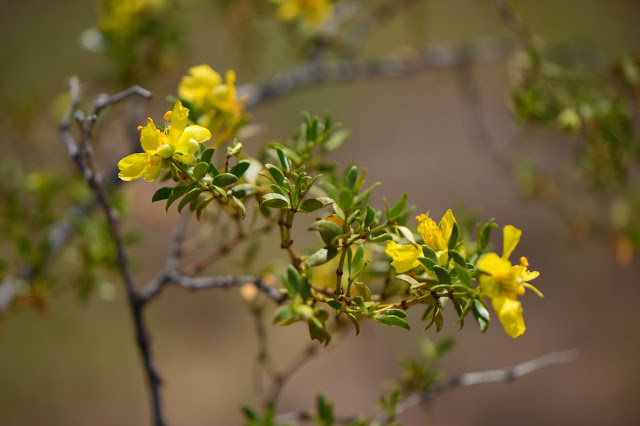 |
| A shady spot just after winter rain |
There are, of course, many different regions within the Sonoran Desert. There is considerable variation even across the city of Phoenix. Our patch (and not a small one!) is influenced by the proximity of the Hassayampa River.
Rivers and aqueducts in the desert are fascinating things with their bright waters flowing through barren plains while herons and other water birds trace their courses overhead. But the Hassayampa River is not like these, being mostly underground with only short sections of flow perennially on the surface. Its name, in fact, is said to mean the "Upside-Down River" -- a very apt description!
But for all that, the land here does have the feeling of a river valley, a lowland; and when it rains we don't argue with it, having been stranded in our vehicle overnight during one of the deluges of 2014... about a mile from home, with rushing water blocking the road both behind and in front of us. It was not a dangerous situation so long as one stayed put, but I must admit it required a good deal of patience! The waters subside about as quickly as they come, but in rainy seasons there is often significant flooding as the excess waters pass through the many washes that stripe and gully the area. Rainwater seems to move across the soil much further than it penetrates into it.
A second factor, also important to the garden, is proximity to more mountainous terrain. This allows our temperatures to be a little lower -- both summer and winter -- than areas closer to the city. Some freezing nights are to be expected; summertime highs are supposedly not as extreme though still hot enough! The highest temperature I noticed last summer was 114 F/46 C, and we had two stretches of freezing nights during this last winter.
 |
| Looking across the nearby ranch at the Vulture Mountains in winter |
In our nearby washes, this changes to a softer topping of sand or else much heavier rock.
These washes are in turn home to their own tiny ecosystems: little thickets of desert trees and seasonal grasses and wildflowers. These shift gradually to the creosote and saguaros of the plains, making a varied tapestry across the whole area.
The most common trees in our neighborhood are the mesquite (Prosopis velutina) with its delicate leaves...
...and muted yellow chenille catkins...
...and the Blue Palo Verde (Parkinsonia floridum), which in spring can be a glory of yellow flowers. (For more on the nearby Palo Verde, which I have written about through most of 2015 with the Tree Following meme, see here.)
Both these trees are legumes and provide important food for wildlife from their pods.
The low-lying areas tend to host ephemeral flowers and grasses. There are many different grasses, but they are perhaps best looked at as a specimen plant here, growing in tufts and swathes rather than a solid cover.
In moist years there is, of course, the marvelous glow of Kallstroemia grandiflora, known as Calltrop or Desert Poppy, but in fact a relative of the Creosote Bush!
Probably the most common wildflower in our neighborhood is Globemallow (Sphaeralcea ambigua), which seems to thrive even in drier conditions so long as there is some shade. Brilliant coral orange (there is some variation) flowers bloom on large, gawky plants with soft, silvery, lobed foliage. Bloom time follows rain, but these seem to be fairly reliable plants even during drier years. They are offered as garden perennials, though their size limits placement as they can have a tremendous sprawl!
And if you watch carefully, there are the tiny bells of Dichelostemma capitatum, a cormous species which sprouts in the most inhospitable places.
Moving onto even higher ground one finds the iconic saguaro cactus (Carnegiea gigantea), but they are not so frequent here as they are on the rocky hillsides in other parts of the region.
 |
| Carnegiea gigantea, with small scattered shrubs of Larrea tridenta (see below) at their feet |
Two other cactus species are common locally: the showiest is the Barrel or Fishhook Cactus (Ferrocactus emoryii), with its brilliant red blooms which open just as summer rains begin.
It is not so spectacular the rest of the year, but still worth looking at and walking carefully around!
 |
| At rough estimate, this one is about 3.5 ft (1 m) tall |
There are also the Chollas (Opuntia spp.), some of the prickliest of them all. Unlike the Ferrocactus, these grow happily in the wash in our neighborhood and their pale green blends in with the grasses of the monsoon season.
But in this area the most definitive plant is probably the so-called Creosote Bush (Larrea tridentata). It spreads (in sparse desert fashion) across the empty areas, forming a shrubby green haze that gives an illusion of verdure. It tends to be spaced widely, and I have read that it exudes a chemical that inhibits growth of nearby plants, though other sources say nothing about this and it seems to be acceptable for garden use.
Its fresh, sharp scent fills the air when the weather turns moist. It grows either low or high, depending on the availability of moisture. Never (so far as I know) entirely leafless, it puts on a new flush of glossy foliage during wet seasons, then adds some admittedly non-descript yellow blooms...
And when nearly bare, its striped branches are fascinating in themselves.
As can be imagined, where there is a little more water, there will also be animals. Lizards are plentiful...
...but we also have a plethora of toad species, from various spadefoots (which I think is the type below) to the Colorado River toad, whose poison glands present a serious danger to dogs unwary enough to pester them. In moist weather in summer, the air is full of the sound of singing toads! They do a noticably good job of bug control. (They may also attract rattlesnakes, which I am not looking at in this post, though they are plentiful...)
Also associated with the presence of water are the dragonflies which occasionally appear.Happily, there are also plenty of bees!
 |
| Bee in Ferrocactus flower |
 |
| House Finch, originally native here though it spread across much of the rest of the country during the last century |
 |
| Curve-billed Thrasher |
| Female Anna's Hummingbird in the garden |




















Is that pollen on the hummingbird's bill? (yellow)
ReplyDeleteProbably so, Hollis -- I see it on her frequently when photographing, and I've read that Anna's tend to get pollen on the bill.
DeleteThanks for a look at the wild side of the Sonoran Desert countryside, Amy. There's a lot of beauty to be found. I love that desert poppy!
ReplyDeleteI am really hoping to find a way to grow desert poppies in the garden, Kris - wouldn't they be wonderful! I've read they can take up to three years to germinate (beyond my patience, especially as they are annuals?!), but another author makes it sound a bit easier so perhaps I'll give it a try if I can get some seed. We had a little stand out by our orange tree last summer... They're certainly adapted to the region!
DeleteThere is much life in the desert, if you know where to look.
ReplyDeleteIndeed there is, and scouting for it is quite interesting... :)
Deleteanother fascinating read, Amy. The dragonfly images are stunning!
ReplyDeleteThanks a lot, Ann! It was interesting photographing the dragonflies as they are so much larger than my usual insect models: bees. I hope to see more dragonflies this summer as they are wonderful creatures!
DeleteA lovely post Amy! It is so interesting to read about your beautiful environment and you describe it so well. I loved the Chenille catkins - exactly like chenille and the spines on the Chollas are something else! I would not want to pick a fight with one of those! Lol! Your photography of all your flora and fauna is gorgeous - looking forward to seeing more as we approach spring!
ReplyDeleteHave a great week.
- Kate
Sometimes I think those Chollas would be safer if they were a bit larger and more visible! My sister and I had a running debate about whether our young, bouncy BettyTheDog had some instinct for avoiding prickles (and snakes) when leaping blindly into tall brush... till we had to pull cholla spines out of her :( Admittedly, it only happened once! It's so nice to have spring weather to lure one out to take pictures. Thanks so much, Kate :)
DeleteIt is interesting to see and read about the different plants, insects and birds that live in your area. It is so different from the landscape we have here in Worcestershire UK.
ReplyDeleteIt's been quite a learning experience, Brian, even coming from the Midwest! I knew about some of the plants and animals by name or description, but living (and gardening) around them is a different matter! At the same time, it's been a treat to have access to blogs from beautifully green places like yours. And to see plants and animals that I still have only read about ;-)
Delete